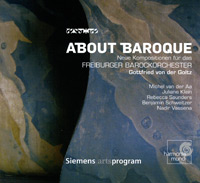BENJAMIN SCHWEITZER (b.1973): flekkicht for Strings, 2 Flutes, 2 Oboes, Bassoon, 2 Horns, Harpsichord and Lute, NADIR VASSENA (b.1970): Bagatelle trascendentali for Lute, Viola da Gamba, Violin, Viola d'amore, 2 Cellos, Double Bass and Harpsichord, MICHEL VAN DER AA (b.1970): Imprint for Violin, Cello, Strings, 2 Oboes, Harpsichord and Organ, JULIANE KLEIN (b.1966): ...und folge mir nach for Violin, Strings, 2 Flutes, 2 Oboes, 2 Bassoons, 2 Horns and Harpsichord, REBECCA SAUNDERS (b.1967): Rubricare for Strings and Organ.

Catalogue Number: 03I097
Label: Harmonia Mundi
Reference: HMC 905187.88
Format: CD
Price: $25.98
Description: Because they were writing for an ensemble ostensibly focused on Baroque repertoire and performance practices, these composers all addressed the conventions of earlier musical styles in their pieces, each in their own fashion, and all in a decidedly modern idiom. For Schweitzer this involves the adoption of the timbres of Baroque instrumentation and a certain block-textured approach to orchestration in a solidly constructed modern 'concerto grosso'. Vassena makes great play of the interaction between two quintessentially Baroque solo instruments freely interacting with the orchestra. The relationship between contrasting material can be clearly heard to evolve, lending the work a definite sense of progression. Aa's instrumentally virtuosic Imprint employs fragments of material exemplifying baroque performance practice, sometimes hectically or obsessively repeated, which form the building blocks of a texturally rich and propulsive orchestral fantasia, surprisingly accessible, given the idiom which (like all the other works here pays scant attention to tonality or conventional harmony [though this piece gets a good deal closer than the others]). The Klein involves a collaborative element with the performers, suggesting the improvisatory element in Baroque performance reimagined in very contemporary terms; the orchestra is subdivided into small groups (with a centrally placed violin soloist who contributes cadenza-like material) which interact according to some degree of aleatoric choice structure (not precisely explained in the English notes). Saunders' Rubricare is a study in string sonority, and the piece that displays the least obvious connection to any element of Baroque style; dissonant clusters and hectic gestures invoke the rage and passion associated with the color red innocuously suggested by the title. 2 CDs. Freiburg Baroque Orchestra; Gottfried von der Goltz.
